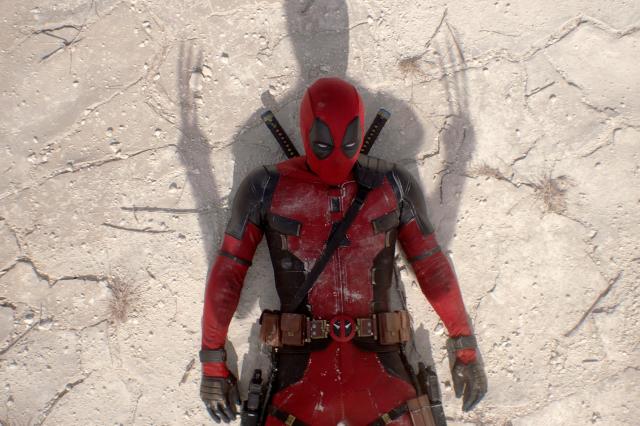“Deadpool & Wolverine” made nearly a half-billion dollars in its first week worldwide. With Ryan Reynolds as Wade Wilson, aka Deadpool. (20th Century Studios/Marvel Studios via AP)
With “Deadpool & Wolverine” hauling in nearly a half-billion dollars worldwide in its first week alone, theater owners are breathing a sigh of temporary relief, with a smaller but notable half-sigh provided by the strong showing of “Twisters.” It’s not Barbenheimer but we don’t always get the summer doubleheaders we want.
I’m still sorting through why I hated “Deadpool & Wolverine,” especially after finding “Deadpool 2” a really good time in a similar R-rated, superviolent, super-sweary vein. So I called my friend Gordon Purcell. I’ve known Purcell since my first year of college at the University of Minnesota. We acted in plays here and there as undergrads and even then, his prodigious drawing skills pointed to an actual, viable future pursuing a career he actually, viably wanted to pursue.
Now 65, Purcell is a well-respected freelance comics artist with scads of contract work on his resume for DC Comics, Marvel and many other publishers large and smaller. He’s best known for a long association with “Star Trek.” He’s also an avid movie fan, and he liked “Deadpool & Wolverine” a lot, so I thought, well, let’s go. Let’s talk about how action and violence can be visualized on paper, and how that relates to — or differs from — the Bam! and the Pow! and, in a rougher, bloodier vein, the splurch and the dismemberment we often see on screen.
We talked about problematic superhero movie directors and good ones, and his favorite superhero trilogy (which surprised me).
“I don’t know if our friendship can withstand a difference of opinion on this one,” I told Purcell, who’s squarely with this massive hit’s 78% approval rating on Rotten Tomatoes. No sweat, he replied. “My Wolverine blades are out and ready.”
Our conversation has been edited for clarity and length.
Q: So what’s your theory on why “Deadpool & Wolverine” has drawn a fairly wide range of responses from both true Marvel fans and lots of other moviegoers? Though the love, obviously, is very strong.
A: Well, I think a lot of people don’t know what they’re getting into. There’s a lot of bad language, not just (an expletive), but these elaborate, descriptive sexual things which go pretty far. Further than most of what some people have heard and seen in the movies, period. So that’s different.
Q: Also a selling point. The aggressive outrageousness.
A: Right. Now, I know you had issues with the more extreme violence. With these two characters, Deadpool (played by Ryan Reynolds) and Wolverine (Hugh Jackman), they can recover from anything pretty quickly. Regeneration is one of their shared gimmicks. So when they’re maiming and basically killing each other over and over, breaking each other’s legs or spines or whatever, they just regenerate and start over again. To me that makes it more cartoony, but I can see why some people are upset about how it’s depicted. Did you see the second “Suicide Squad” movie? The one James Gunn directed?
Joel Kinnaman, John Cena, Margot Robbie, Peter Capaldi and Idris Elba in the 2021 release “The Suicide Squad.” (Jessica Miglio/Warner Bros. Pictures and AP)
Q: I did. I really liked it! Big flop.
A: I liked it, too. And I think “Deadpool & Wolverine” recalls that one: R-rated, lots of violence, a lot of really good actors. It helps to have different kinds of actors (in movies like this). In this one, Hugh Jackman’s giving a really strong performance, and it lets Ryan Reynolds sort of bounce off him the whole way.
Q: With “Deadpool 2” I got a real charge out of the stunt work, because you could see it, and appreciate the design of it, even in scenes full of digital effects. It’s a big step down to “Deadpool & Wolverine.” You just don’t have the same directorial skill level with the action this time.
A: I get what you’re saying. For me the same sort of thing happens (looking at) the first “Suicide Squad” movie and the second one. At one point in the first one you have this supermodel fighting a tornado of trash. That’s not visually interesting. But James Gunn, with the second one, he’s a clever director, and he knows how to work with a movie full of digital effects.
Margot Kidder as Lois Lane, with Christopher Reeve as Superman in 1978’s “Superman: The Movie.” (Warner Bros.)
Q: Is violence in a comic book the same kind of experience as watching it in a superhero movie?
A: No, it’s different in a comic book. It’s a lot easier to take in a flat, two-dimensional image. And you can read it, take it in, at your own pace. What I do for a living depends so much on the creators (of the characters), the writers, and how bloody they want to get with it. For a long time in comics they’d keep the heavy violence off-panel. There’s a famous 1950s EC Comics horror comic controversy about what you could and couldn’t get away with. When I started working in the 1980s, more of these things were still implied. And it didn’t look photorealistic.
Q: Do you think some directors choose to ignore how the action and the violence changes medium to medium? With Zack Snyder —
A: See, that’s a different issue for me. I may not like his movies very much, but it’s because with Superman and Batman he’s treating them like gods. In every shot it’s like they’re statues or something. They have no humor at all. Superman’s killing people? Not in character. Deadpool, fine. You have to pay attention to where these characters are coming from. Patty Jenkins, and that first “Wonder Woman” movie she directed in particular — she really understood the material, and the character, and what to do with it. That’s easily one of the best DC Comics movies.
The 2017 movie “Wonder Woman” starring Gal Gadot. (Warner Bros.)
Q: Let’s go through some other favorites of yours.
A: The first “Superman” in 1978, at least up until Otis (Ned Beatty) shows up. For me that’s a perfect superhero movie. The second “Spider-Man” with Tobey Maguire — one of the greatest. Alfred Molina (who played Doc Ock) is just the best villain. But I probably like “Captain America: The Winter Soldier” the best of all. In fact that’s my favorite superhero trilogy, those first three “Captain America” movies. But I love what Sam Raimi does as a director, especially in “Spider-Man 2.” In fact didn’t you and I go to a screening of “Evil Dead II”?
Q: Good memory! Back in 1987. So, to recap: For you, and a few other people in the world, you’re down with “Deadpool & Wolverine.”
A: Yeah. I think it moves well enough. Some of the earlier Marvel movies felt really long to me. This one’s about right.
“Deadpool & Wolverine” continues in theaters.
Michael Phillips is a Tribune critic.

